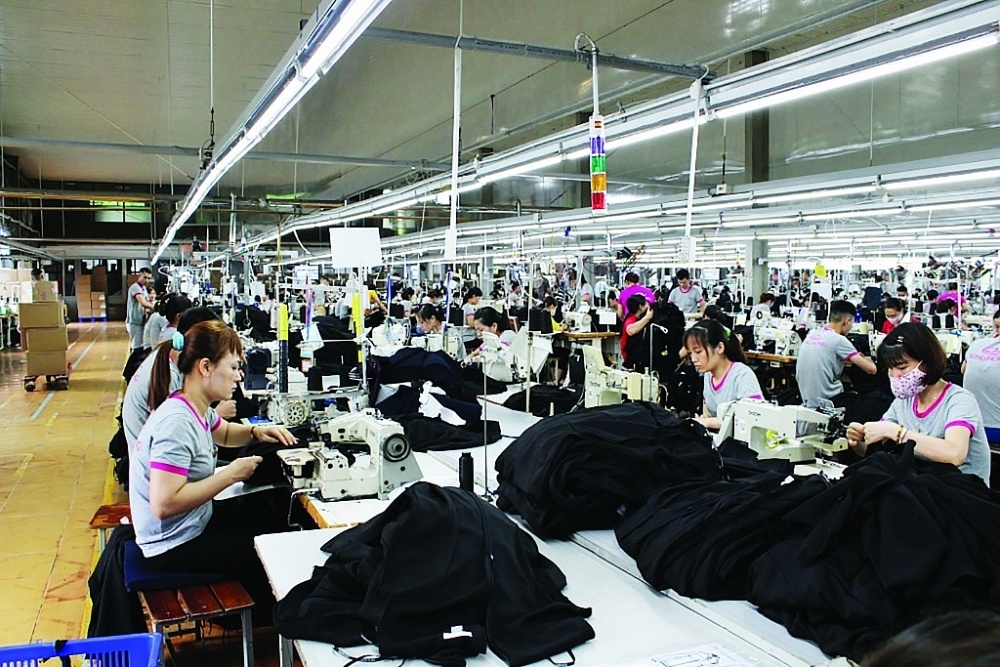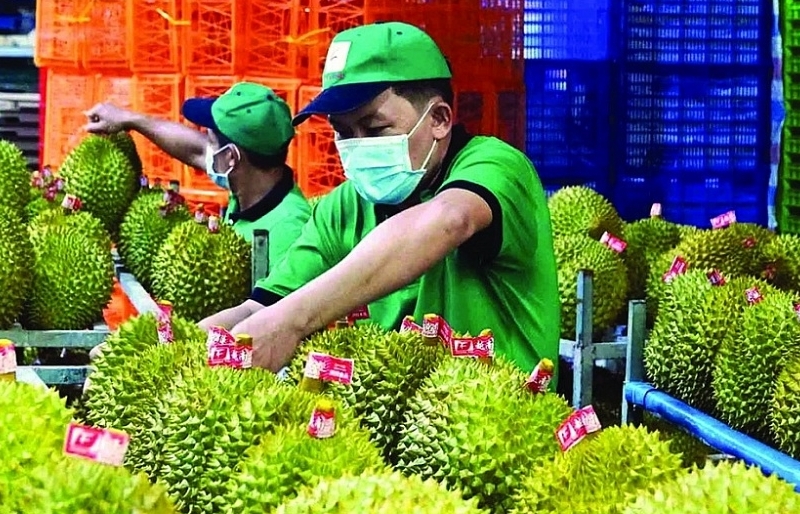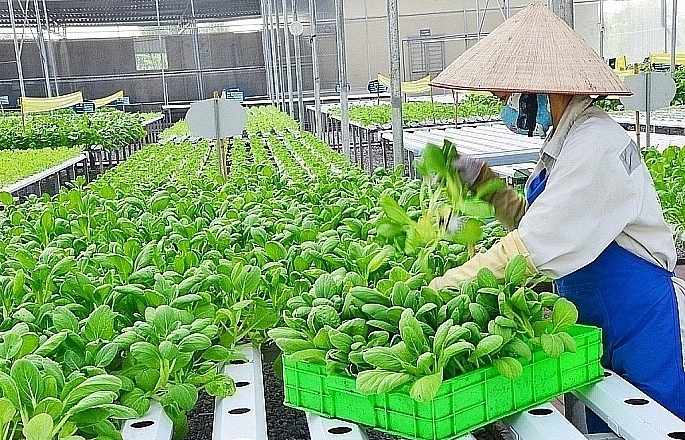Authorized economic operator (AEO): Effectiveness in global supply chains
| Authorized Economic Operator enjoys strong incentives | |
| AEOs: Great incentives, high responsibility |
 |
| Businesses enjoy numerous benefits when recognized as AEOs. In the photo: manufacturing activities at Song Hong Corporation - a company recognized as an AEO by the General Department of Customs. Photo: H. Nu |
Mutual benefits
The recognition of AEOs is also reflected in regulations in Free trade agreements (FTA). Particularly, in the newer FTAs like the EU-Vietnam Free Trade Agreement (EVFTA), the Comprehensive and Progressive Agreement for Trans-Pacific Partnership (CPTPP), or the Regional Comprehensive Economic Partnership (RCEP), there is a chapter on customs procedures and measures to facilitate trade. Accordingly, Vietnam and their FTA partners agree to enhance cooperation in the customs field and administrative support to ensure legal compliance and corresponding customs procedures, meeting the objectives of promoting trade facilitation while ensuring effective customs control operations.
Furthermore, international standards on customs and global trade facilitation by the World Trade Organization (WTO) and the World Customs Organization (WCO), such as implementing the HS Convention, the revised Kyoto Convention (RKC), the Framework of Standards to Secure and Facilitate Global Trade (SAFE), risk management, advance rulings, protection of intellectual property rights, and facilitating the transit of goods, are detailed.
International organizations' evaluations indicated that the AEO program has brought numerous benefits, enhancing customs security control and helping manage the supply chain seamlessly from start to finish. Specifically, the AEO program has established standards that allow customs authorities to modernize by fostering partnerships with businesses, specialized agencies, and customs authorities of other countries. Additionally, it assists in implementing a system to receive information before goods arrive at the border, analyzing risks before goods arrive, and establishing an information exchange system with AEOs and domestic management agencies, as well as customs authorities of partner countries on a regular and continuous basis.
The AEO program is applied in over 100 countries, making AEO recognition a competitive advantage for businesses in the same industry or business sector.
In Vietnam, the AEO program has been implemented by the General Department of Customs since 2011. After 12 years of implementation, the practical benefits that the AEO program has brought to recognized businesses and customs authorities are evident. It contributes to strengthening and improving the customs-business partnership, playing a significant role in socio-economic development, attracting foreign investment, enhancing the country's position in the international community, and especially, being a program that the business community always desires to participate in.
As of now, Vietnam Customs has recognized AEO status for 73 businesses. This result is a crucial step, providing a foundation for Vietnam to negotiate and sign mutual recognition agreements (MRAs) with customs authorities of other countries.
According to the AEOs, since joining the program, businesses have enjoyed various benefits. Statistics clearly showed that after being recognized, businesses saved administrative procedure costs and warehouse storage fees, averaging from VND1 to 5 billion per year.
Businesses also noted that before being recognized as an AEO, customs inspection procedures led to delays in production plans, affecting delivery schedules. However, after obtaining AEO recognition, businesses benefit from various customs procedure advantages, ensuring delivery deadlines for partners. This has helped enhance the credibility of businesses with their partners.
Additionally, enjoying benefits has shortened customs clearance times, reducing administrative procedure costs and personnel costs, including reducing the number of employees and working hours. Moreover, for imported goods for business purposes, enterprises clear customs immediately and pay taxes later for batches cleared in the previous month. Therefore, businesses save interest payments to banks for tax payment, actively managing business capital.
Remaining challenges
According to the assessment of the Customs authorities, the AEO program reflects the development and innovation of Vietnam Customs. Over more than 10 years of implementing the AEO program, it has shown continuous progress in both scale and quality, increasingly aligning with the WCO's SAFE Framework for AEO Programs. This contributes to enhancing the position of Vietnam Customs while promoting the signing of mutual recognition agreements (MRAs) on AEO between Vietnam and countries in the region and around the world
Despite notable achievements, the implementation of the AEO program has revealed some existing challenges.
Firstly, policies and legal bases regarding the preferential regime are not consistent with other regulations. This inconsistency is due to the fact that some provisions cannot be implemented due to both objective and subjective reasons.
Secondly, some AEOs in Vietnam, when recognized, are still not fully aware of their responsibility in maintaining and making efforts to implement internal control mechanisms to ensure legal compliance as prescribed. There are still instances of customs procedure violations, and recommendations from customs authorities have not been implemented or have been implemented slowly.
Thirdly, currently, Vietnam's AEO program only applies to businesses engaged in import and export activities, not extending to other economic entities participating in the supply chain, as recommended by the WCO in the SAFE Framework. Furthermore, despite legal provisions regarding the application to customs agencies, there are no recognized customs agents. The reason is the lack of specific criteria for recognition and preferential treatment for customs agents.
Fourthly, the number of recognized AEO businesses is still limited, accounting for only 0.1% of the total 70,000 import-export units. Reasons for this include limited communication about the AEO program, with many businesses unaware of the program to participate. The AEO approval criteria are high, especially in terms of import-export turnover. This hinders the participation of small and medium-sized enterprises (SMEs), while Vietnam is witnessing the rise of SMEs. According to statistics from the General Statistics Office, the number of SMEs accounts for over 70% of the total number of businesses nationwide.
Fifthly, cooperation and coordination within the industry to implement this program are still limited, lacking investment in depth. Local customs units have not yet reached a consensus.
Finally, the authority to sign MRAs with customs authorities of other countries still faces difficulties and has not fully realized the potential of the AEO mechanism. National law has not specifically regulated the authority to sign MRAs regarding AEOs in the customs field.
Related News

Vietnamese businesses in the face of the wave of international e-commerce platforms: Benefits and challenges
10:05 | 14/11/2024 Headlines

Sharing responsibility for ensuring security and safety of the supply chain
07:13 | 03/11/2024 Import-Export

AEOs make great contributions to Vietnam’s trade development
07:40 | 16/10/2024 Customs

Extending AEO regime for Chang Shin Vietnam Co., Ltd
14:42 | 27/08/2024 Import-Export
Latest News

Building a brand to elevate Vietnamese rice
10:52 | 27/12/2024 Import-Export

FTA Index helps measure the effectiveness of FTA implementation
10:51 | 27/12/2024 Import-Export

Nghệ An Province anticipates record FDI amidst economic upswing
15:49 | 26/12/2024 Import-Export

Green farming development needs supportive policies to attract investors
15:46 | 26/12/2024 Import-Export
More News

Vietnamese enterprises adapt to green logistics trend
15:43 | 26/12/2024 Import-Export

Paving the way for Vietnamese agricultural products in China
11:08 | 26/12/2024 Import-Export

VN seafood export surpass 2024 goal of $10 billion
14:59 | 25/12/2024 Import-Export

Exporters urged to actively prepare for trade defence investigation risks when exporting to the UK
14:57 | 25/12/2024 Import-Export

Electronic imports exceed $100 billion
14:55 | 25/12/2024 Import-Export

Forestry exports set a record of $17.3 billion
14:49 | 25/12/2024 Import-Export

Hanoi: Maximum support for affiliating production and sustainable consumption of agricultural products
09:43 | 25/12/2024 Import-Export

Việt Nam boosts supporting industries with development programmes
13:56 | 24/12/2024 Import-Export

VN's wood industry sees chances and challenges from US new trade policies
13:54 | 24/12/2024 Import-Export
Your care

Building a brand to elevate Vietnamese rice
10:52 | 27/12/2024 Import-Export

FTA Index helps measure the effectiveness of FTA implementation
10:51 | 27/12/2024 Import-Export

Nghệ An Province anticipates record FDI amidst economic upswing
15:49 | 26/12/2024 Import-Export

Green farming development needs supportive policies to attract investors
15:46 | 26/12/2024 Import-Export

Vietnamese enterprises adapt to green logistics trend
15:43 | 26/12/2024 Import-Export





